Python - Django - ORM 实例
准备工作:
首先创建一个名为 Py_Django 的数据库
新建项目,名为 mysite0
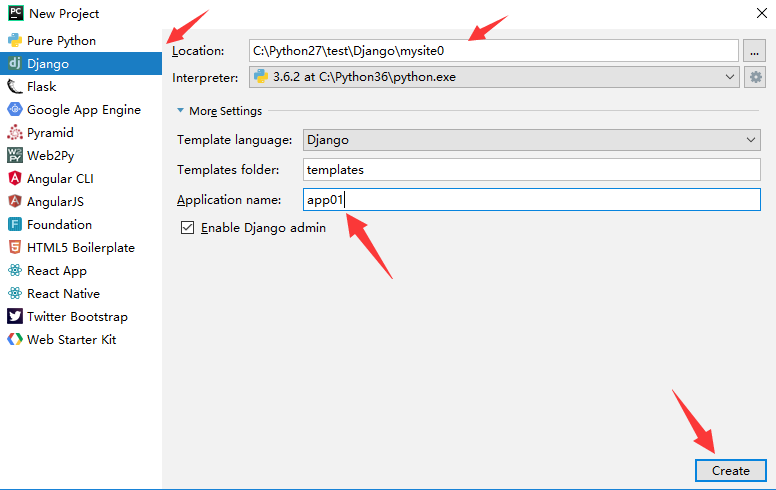
创建完成后需要进行几项配置
mysite0/settings.py 下
首先是 html 文件相关

其次是数据库配置

最后注释掉 CSRF 的代码
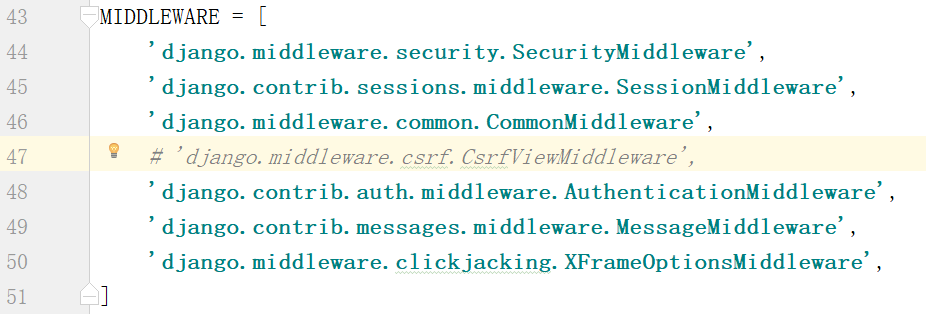
在 mysite0/__init__.py 中添加以下代码
import pymysql pymysql.install_as_MySQLdb()
app01/models.py 中写上创建表的类
from django.db import models # Create your models here. # 出版社
class Publisher(models.Model):
id = models.AutoField(primary_key=True) # 自增的 id 主键
# 创建一个 varchar(64) 的唯一的不为空的字段
name = models.CharField(max_length=64, null=False, unique=True)
执行一下两条命令来创建表
python manage.py makemigrations
python manage.py migrate
连接数据库,创建三条数据
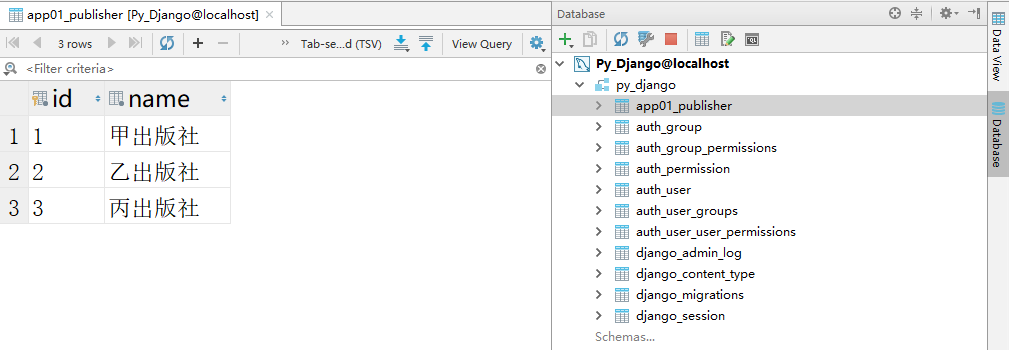
展示出版社列表:
publisher_list.html:
<!DOCTYPE html>
<html lang="en">
<head>
<meta charset="UTF-8">
<title>出版社列表</title>
</head>
<body> <table border="1">
<thead>
<tr>
<th>序号</th>
<th>ID</th>
<th>出版社名称</th>
</tr>
</thead>
<tbody>
{% for publisher in publisher_list %}
<tr>
<td>{{ forloop.counter }}</td>
<td>{{ publisher.id }}</td>
<td>{{ publisher.name }}</td>
</tr>
{% endfor %} </tbody>
</table>
</body>
</html>
第几次循环,forloop.counter 的值就是多少
app01/views.py 中 publisher_list 函数:
from django.shortcuts import render
from app01 import models # Create your views here. # 展示出版社列表
def publisher_list(request):
# 去数据库查出所有的出版社,填充到 html 中,返回给用户
ret = models.Publisher.objects.all().order_by("id") # order_by("id") 通过 id 进行排序
return render(request, "publisher_list.html", {"publisher_list": ret})
在 mysite0/urls.py 中添加对应关系
from django.conf.urls import url
from django.contrib import admin
from app01 import views urlpatterns = [
url(r'^admin/', admin.site.urls),
url(r'^publisher_list/', views.publisher_list),
]
运行结果:
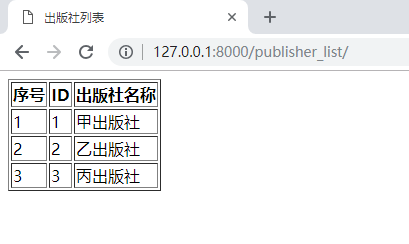
添加出版社:
修改 publisher_list.html:
<!DOCTYPE html>
<html lang="en">
<head>
<meta charset="UTF-8">
<title>出版社列表</title>
</head>
<body> <table border="1">
<thead>
<tr>
<th>序号</th>
<th>ID</th>
<th>出版社名称</th>
</tr>
</thead>
<tbody>
{% for publisher in publisher_list %}
<tr>
<td>{{ forloop.counter }}</td>
<td>{{ publisher.id }}</td>
<td>{{ publisher.name }}</td>
</tr>
{% endfor %} </tbody>
</table> <a href="/add_publisher/">添加新的出版社</a> </body>
</html>
创建 add_publisher.html:
<!DOCTYPE html>
<html lang="en">
<head>
<meta charset="UTF-8">
<title>添加出版社</title>
</head>
<body> <h1>添加出版社</h1> <form action="/add_publisher/" method="post">
<input type="text" name="publisher_name">
<input type="submit" value="提交">
</form> </body>
</html>
在 app01/views.py 中添加 add_publisher 函数:
from django.shortcuts import render, redirect
from app01 import models # Create your views here. # 展示出版社列表
def publisher_list(request):
# 去数据库查出所有的出版社,填充到 html 中,返回给用户
ret = models.Publisher.objects.all().order_by("id") # order_by("id") 通过 id 进行排序
return render(request, "publisher_list.html", {"publisher_list": ret}) # 添加新的出版社
def add_publisher(request):
# 如果是 POST 请求,就获取用户填写的数据
if request.method == "POST":
new_publisher = request.POST.get("publisher_name")
# 获得数据后去数据库中新增一条数据
models.Publisher.objects.create(name=new_publisher)
# 添加成功后进行跳转
return redirect("/publisher_list/") # 用户来到该界面返回的 html 页面
return render(request, "add_publisher.html")
在 mysite0/urls.py 中添加对应关系
from django.conf.urls import url
from django.contrib import admin
from app01 import views urlpatterns = [
url(r'^admin/', admin.site.urls),
url(r'^publisher_list/', views.publisher_list),
url(r'^add_publisher/', views.add_publisher),
]
运行结果:
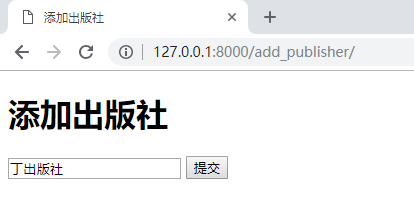
添加一个“丁出版社”

删除出版社:
修改 publisher_list.html,添加删除按钮
<!DOCTYPE html>
<html lang="en">
<head>
<meta charset="UTF-8">
<title>出版社列表</title>
</head>
<body> <table border="1">
<thead>
<tr>
<th>序号</th>
<th>ID</th>
<th>出版社名称</th>
<th>操作</th>
</tr>
</thead>
<tbody>
{% for publisher in publisher_list %}
<tr>
<td>{{ forloop.counter }}</td>
<td>{{ publisher.id }}</td>
<td>{{ publisher.name }}</td>
<td>
<a href="/del_publisher/?id={{ publisher.id }}">删除</a>
</td>
</tr>
{% endfor %} </tbody>
</table> <a href="/add_publisher/">添加新的出版社</a> </body>
</html>
app01/views.py 中添加 del_publisher 函数
from django.shortcuts import render, redirect, HttpResponse
from app01 import models # Create your views here. # 展示出版社列表
def publisher_list(request):
# 去数据库查出所有的出版社,填充到 html 中,返回给用户
ret = models.Publisher.objects.all().order_by("id") # order_by("id") 通过 id 进行排序
return render(request, "publisher_list.html", {"publisher_list": ret}) # 添加新的出版社
def add_publisher(request):
# 如果是 POST 请求,就获取用户填写的数据
if request.method == "POST":
new_publisher = request.POST.get("publisher_name")
# 获得数据后去数据库中新增一条数据
models.Publisher.objects.create(name=new_publisher)
# 添加成功后进行跳转
return redirect("/publisher_list/") # 用户来到该界面返回的 html 页面
return render(request, "add_publisher.html") # 删除出版社
def del_publisher(request):
# 从 GET 请求的参数中拿到要删除的 id 值
del_id = request.GET.get('id', None) # 取不到 id 值的话,默认为 None
# 如果取到 id 值,就去数据库中删除该 id 的数据
if del_id:
# 根据 id 查找数据,并删除
del_obj = models.Publisher.objects.get(id=del_id).delete()
# 删除后返回页面
return redirect("/publisher_list/")
else:
return HttpResponse("要删除的数据不存在!")
mysite0/urls.py 中添加对应关系
from django.conf.urls import url
from django.contrib import admin
from app01 import views urlpatterns = [
url(r'^admin/', admin.site.urls),
url(r'^publisher_list/', views.publisher_list),
url(r'^add_publisher/', views.add_publisher),
url(r'^del_publisher/', views.del_publisher),
]
运行结果:
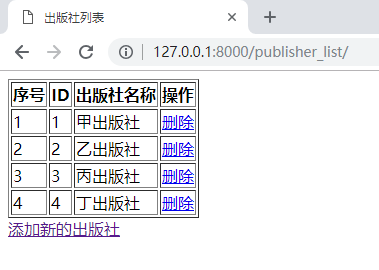
点击删除丁出版社
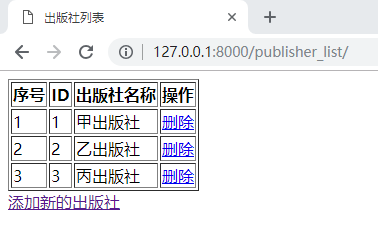
页面闪了一下,丁出版社就被删除了
编辑出版社:
修改 publisher_list.html
<!DOCTYPE html>
<html lang="en">
<head>
<meta charset="UTF-8">
<title>出版社列表</title>
</head>
<body> <table border="1">
<thead>
<tr>
<th>序号</th>
<th>ID</th>
<th>出版社名称</th>
<th>操作</th>
</tr>
</thead>
<tbody>
{% for publisher in publisher_list %}
<tr>
<td>{{ forloop.counter }}</td>
<td>{{ publisher.id }}</td>
<td>{{ publisher.name }}</td>
<td>
<a href="/del_publisher/?id={{ publisher.id }}">删除</a>
<a href="/edit_publisher/?id={{ publisher.id }}">编辑</a>
</td>
</tr>
{% endfor %} </tbody>
</table> <a href="/add_publisher/">添加新的出版社</a> </body>
</html>
edit_publisher.html:
<!DOCTYPE html>
<html lang="en">
<head>
<meta charset="UTF-8">
<title>编辑出版社</title>
</head>
<body> <h1>编辑出版社</h1> <form action="/edit_publisher/" method="post">
<input type="text" name="id" value="{{ publisher.id }}" style="display: none">
<input type="text" name="publisher_name" value="{{ publisher.name }}">
<input type="submit" value="提交">
</form> </body>
</html>
在 app01/views.py 中添加 edit_publisher 函数
from django.shortcuts import render, redirect, HttpResponse
from app01 import models # Create your views here. # 展示出版社列表
def publisher_list(request):
# 去数据库查出所有的出版社,填充到 html 中,返回给用户
ret = models.Publisher.objects.all().order_by("id") # order_by("id") 通过 id 进行排序
return render(request, "publisher_list.html", {"publisher_list": ret}) # 添加新的出版社
def add_publisher(request):
# 如果是 POST 请求,就获取用户填写的数据
if request.method == "POST":
new_publisher = request.POST.get("publisher_name")
# 获得数据后去数据库中新增一条数据
models.Publisher.objects.create(name=new_publisher)
# 添加成功后进行跳转
return redirect("/publisher_list/") # 用户来到该界面返回的 html 页面
return render(request, "add_publisher.html") # 删除出版社
def del_publisher(request):
# 从 GET 请求的参数中拿到要删除的 id 值
del_id = request.GET.get('id')
# 如果取到 id 值,就去数据库中删除该 id 的数据
if del_id:
# 根据 id 查找数据,并删除
del_obj = models.Publisher.objects.get(id=del_id).delete()
# 删除后返回页面
return redirect("/publisher_list/")
else:
return HttpResponse("要删除的数据不存在!") # 编辑出版社
def edit_publisher(request):
# 获取 POST 发来的数据,并更新到数据库中
if request.method == "POST":
# 获取 POST 传送来的 id 值和出版社
edit_id = request.POST.get('id')
new_name = request.POST.get('publisher_name')
# 根据 id 取得出版社
publisher = models.Publisher.objects.get(id=edit_id)
publisher.name = new_name
publisher.save() # 把修改的结果提交到数据库
return redirect("/publisher_list/") # 跳转到列表页面 # 从 GET 请求中取得 id 值
publisher_id = request.GET.get('id')
if publisher_id:
# 获取当前编辑的出版社对象
publisher_obj = models.Publisher.objects.get(id=publisher_id)
return render(request, "edit_publisher.html", {"publisher": publisher_obj})
else:
return HttpResponse("编辑的出版社不存在!")
在 mysite0/urls.py 中添加对应关系
from django.conf.urls import url
from django.contrib import admin
from app01 import views urlpatterns = [
url(r'^admin/', admin.site.urls),
url(r'^publisher_list/', views.publisher_list),
url(r'^add_publisher/', views.add_publisher),
url(r'^del_publisher/', views.del_publisher),
url(r'^edit_publisher/', views.edit_publisher),
]
运行结果:
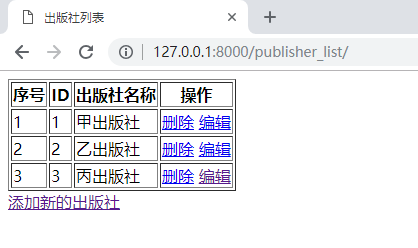
编辑“丙出版社”
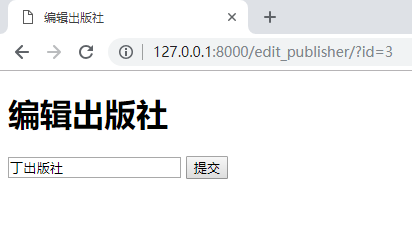
改为“丁出版社”
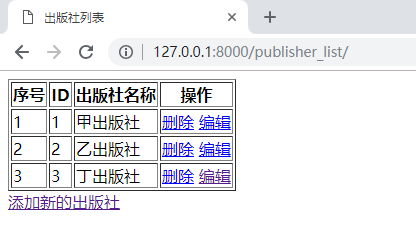
Python - Django - ORM 实例的更多相关文章
- Python - Django - ORM 实例(二)
在 app01/models.py 中添加 Book 类对象表 from django.db import models # Create your models here. # 出版社 class ...
- Python - Django - ORM 多对多表结构的三种方式
多对多的三种方式: ORM 自动创建第三张表 自己创建第三张表, 利用外键分别关联作者和书,关联查询比较麻烦,因为没办法使用 ORM 提供的便利方法 自己创建第三张表,使用 ORM 的 ManyToM ...
- Python - Django - ORM 操作表
ORM 的对应关系: 类 ---> 数据库表对象 ---> 数据库行属性 ---> 字段 操作数据库表 ---> ...
- Python - Django - ORM 查询方法
models.py: from django.db import models class Human(models.Model): id = models.AutoField(primary_key ...
- python django ORM
1.在models.py中创创建类 # -*- coding: utf-8 -*- from __future__ import unicode_literals from django.db imp ...
- Python Django ORM 字段类型、参数、外键操作
AutoField(Field) - int自增列,必须填入参数 primary_key=True BigAutoField(AutoField) - bigint自增列,必须填入参数 primary ...
- Python Django ORM基本增删改查
工程下的urls.py中增加如下: from cmdb import views as cmdb #要把你要操作的项目import进来 urlpatterns = [ url(r'orm', cmdb ...
- Python Django ORM创建基本类以及生成数据结构
#在项目目录下的modules.py中创建一个类,来自动生成一张表UserInfo class UserInfo(models.Model): username = models.CharField( ...
- python - django (ORM使用步骤)
print('asd') """ # 1. 手动创建一个数据库 # 2. 在 Django 项目中设置连接数据库的相关配置(告诉Django 连接哪一个数据库) 在 DA ...
随机推荐
- Java语言基础——数据类型与运算符
标识符: 1.组成元素由字母.数字.下划线.美元符号($) 2.标识符不能以数字开头 3.标识符严格区分大小写 4.标识符的命名要有意义(见名知意) 注释: 1.单行注释 // 2.多行注释 /* 注 ...
- paho.mqtt.embedded-c MQTTPacket transport.c hacking
/******************************************************************************* * paho.mqtt.embedde ...
- 大家一起做训练 第一场 G CD
题目来源:UVA 624 题目的意思就是:我现在需要从 t 张CD中拿出一部分来,尽可能的凑出接近 N 这么久的音乐,但是不能超过 N. CD不超过20张,每张长度不超过 N ,不能重复选. 一个很简 ...
- (5)subprocess模块(子进程模块)
什么是进程 一个程序运行起来了就是一个进程 但是程序本身不是进程,程序是一对代码而已 所以进程就是一个抽象的概念,就是程序运行起来的一个过程 进程和进程之间是相互独立的,互不影响 如何理解子进程和父进 ...
- idea_快捷键default&eclipse
关键字: SpringMybatisplusRedisApplicationTests github关键字(springboot拦截器完整项目): implements WebMvcConfigure ...
- 使用Visual Studio Code开发Asp.Net Core WebApi学习笔记(三)-- Logger
本篇是在上一篇的基础上添加日志功能,并记录NLog在Asp.Net Core里的使用方法. 第一部分:默认Logger支持 一.project.json添加日志包引用,并在cmd窗口使用 dotnet ...
- test20180919 选择客栈
题意 分析 不难发现把增加人数看成减少人数,上限是w 看成总数是w,问题就变成了询问有多少个子区间没有0. 考虑这个问题困难在哪里,就是区间加减法让我们不好判断0 的位置. 因为题目保证每个位置的值非 ...
- 清理IE和使用历史痕迹
清除IE临时文件的Batch脚本 @echo off title: IE temporary file deleter echo 正在 清除Internet临时文件 ............ RunD ...
- npm bower gulp
npm即nodejs package manager ,是nodeJs的包管理工具,使用前需安装nodeJs(https://www.npmjs.com.cn/getting-started/inst ...
- ThinkPHP5 控制器中怎么实现 where id = 2 or id = 3 这个查询语句?
使用 whereOr whereIn(); (来自 ★C̶r̶a̶y̶o̶n-杭州 ) 为什么不用数组啊,array('eq', array(1,2),'or') (来自 supler)
